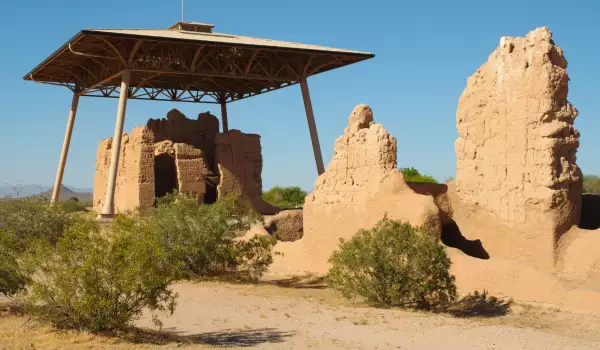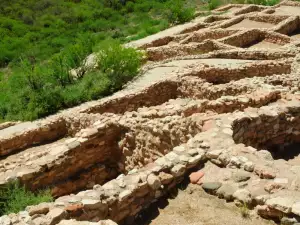Casa Grande Ruins National Monument

Casa Grande Ruins National Monument is in Coolidge, Arizona, close to the town of Casa Grande.
The monument is a place where there are ruins of the Hohokam period. Different type, destination and altitude buildings are surrounded by a common wall. They are made up by people who lived in these places during the Hohokam.

They engaged in farming in the thirteenth century in the Gila Valley. According to archaeologists, humans lived in antiquity in the Sonoran Desert, and built Casa Grande also created a system to irrigate their fields. This system was used until 1450.
In the language of the people of the period Hohokam buildings were called Big Houses - in their language it sounds like Siwan Waa Ki. Translated to Spanish and its buildings so acquired the name Casa Grande, which is the Spanish term for a large house.
The name comes from a large area of the site, which has four buildings, abandoned by people who lived in this place in 1450. The main building was constructed so as to withstand extreme conditions in summer and winter for over seven centuries.
In the 19th century, it had a lot of tourists, who left their own inscriptions and rock “art”. In 1932 a large steel canopy was built, to protect Casa Grande Ruins National Monument in time. It has, in practice, replaced the canopy, built from iron in 1903. The site received a national monument status in 1918.
As people who live in the Casa Grande, have left no written documents or written language, the first written historical evidence of Casa Grande was in 1694 by Padre Eusebio Francisco Kino. He describes the large building named Casa Grande, which is used today. After him, many people began to write essays and articles about the ruins, which attracted public interest in the site.

From 1860, a lot of tourists began to come here, coming to see where the ancient inhabitants of the Sonoran desert lived. With the advent of the railway, more people arrived to see the historic area, which led to huge losses for archaeologists, since many visitors took souvenirs.
Anthropologist Adolph Bandelier visited the ruins of Casa Grande in 1883 and described their historical importance. In 1877 an archaeological expedition started here, known as Hemenway Southwestern Archaeological Expedition. It was sponsored by Mary Hemenway, from Massachusetts. The expedition was headed by the renowned anthropologist Frank Cushing.
Influential residents of Boston convinced Senator George Hoar to petition the Senate of the United States. With this petition to the government, they expressed hope that measures will be taken to protect and restore the ruins.
Restoration work began in 1892 and President Benjamin Harrison proclaimed the territory of one square mile surrounding the ruins of Casa Grande for the first prehistoric and cultural reserve, based in the United States. Most of the visible ruins were unearthed from the ground in 1908. Tourists are respectfully referred to the ruins of the ancient inhabitants of this area, so that they can be appreciated by future generations.















